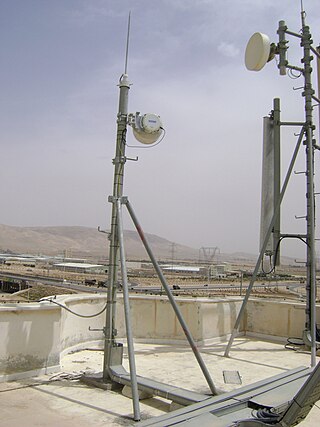
Wireless broadband is a telecommunications technology that provides high-speed wireless Internet access or computer networking access over a wide area. The term encompasses both fixed and mobile broadband.
The ISM radio bands are portions of the radio spectrum reserved internationally for industrial, scientific, and medical (ISM) purposes, excluding applications in telecommunications. Examples of applications for the use of radio frequency (RF) energy in these bands include radio-frequency process heating, microwave ovens, and medical diathermy machines. The powerful emissions of these devices can create electromagnetic interference and disrupt radio communication using the same frequency, so these devices are limited to certain bands of frequencies. In general, communications equipment operating in ISM bands must tolerate any interference generated by ISM applications, and users have no regulatory protection from ISM device operation in these bands.

Ultra high frequency (UHF) is the ITU designation for radio frequencies in the range between 300 megahertz (MHz) and 3 gigahertz (GHz), also known as the decimetre band as the wavelengths range from one meter to one tenth of a meter. Radio waves with frequencies above the UHF band fall into the super-high frequency (SHF) or microwave frequency range. Lower frequency signals fall into the VHF or lower bands. UHF radio waves propagate mainly by line of sight; they are blocked by hills and large buildings although the transmission through building walls is strong enough for indoor reception. They are used for television broadcasting, cell phones, satellite communication including GPS, personal radio services including Wi-Fi and Bluetooth, walkie-talkies, cordless phones, satellite phones, and numerous other applications.

Multichannel multipoint distribution service (MMDS), formerly known as broadband radio service (BRS) and also known as wireless cable, is a wireless telecommunications technology, used for general-purpose broadband networking or, more commonly, as an alternative method of cable television programming reception.

In telecommunications, point-to-multipoint communication is communication which is accomplished via a distinct type of one-to-many connection, providing multiple paths from a single location to multiple locations.

A wireless Internet service provider (WISP) is an Internet service provider with a network based on wireless networking. Technology may include commonplace Wi-Fi wireless mesh networking, or proprietary equipment designed to operate over open 900 MHz, 2.4 GHz, 4.9, 5, 24, and 60 GHz bands or licensed frequencies in the UHF band, LMDS, and other bands from 6 GHz to 80 GHz.

MobileStar Network was a wireless Internet service provider which first gained notability in deploying Wi-Fi Internet access points in Starbucks coffee shops, American Airlines Admiral Club locations across the United States and at Hilton Hotels. Founded by Mark Goode and Greg Jackson in 1998, MobileStar was the first wireless ISP to place a WiFi hotspot in an airport, a hotel, or a coffee shop. MobileStar's core value proposition was to provide wireless broadband connectivity for the business traveler in all the places s/he was likely to "sleep, eat, move, or meet." MobileStar's founder, Mark Goode, was the first to coin the now industry standard expression "hotspot," as a reference to a location equipped with an 802.11 wireless access point.

Worldwide Interoperability for Microwave Access (WiMAX) is a family of wireless broadband communication standards based on the IEEE 802.16 set of standards, which provide physical layer (PHY) and media access control (MAC) options.
The S band is a designation by the Institute of Electrical and Electronics Engineers (IEEE) for a part of the microwave band of the electromagnetic spectrum covering frequencies from 2 to 4 gigahertz (GHz). Thus it crosses the conventional boundary between the UHF and SHF bands at 3.0 GHz. The S band is used by airport surveillance radar for air traffic control, weather radar, surface ship radar, and some communications satellites, especially those satellites used by NASA to communicate with the Space Shuttle and the International Space Station. The 10 cm radar short-band ranges roughly from 1.55 to 5.2 GHz. The S band also contains the 2.4–2.483 GHz ISM band, widely used for low power unlicensed microwave devices such as cordless phones, wireless headphones (Bluetooth), wireless networking (WiFi), garage door openers, keyless vehicle locks, baby monitors as well as for medical diathermy machines and microwave ovens. India's regional satellite navigation network (IRNSS) broadcasts on 2.483778 to 2.500278 GHz.
The V band ("vee-band") is a standard designation by the Institute of Electrical and Electronics Engineers (IEEE) for a band of frequencies in the microwave portion of the electromagnetic spectrum ranging from 40 to 75 gigahertz (GHz). The V band is not heavily used, except for millimeter wave radar research and other kinds of scientific research. It should not be confused with the 600–1,000 MHz range of Band V of the UHF frequency range.
Local multipoint distribution service (LMDS) is a broadband wireless access technology originally designed for digital television transmission (DTV). It was conceived as a fixed wireless, point-to-multipoint technology for utilization in the last mile. LMDS commonly operates on microwave frequencies across the 26 GHz and 29 GHz bands. In the United States, frequencies from 31.0 through 31.3 GHz are also considered LMDS frequencies.
The Unlicensed National Information Infrastructure (U-NII) radio band, as defined by the United States Federal Communications Commission, is part of the radio frequency spectrum used by WLAN devices and by many wireless ISPs.

High-speed multimedia radio (HSMM) is the implementation of high-speed wireless TCP/IP data networks over amateur radio frequency allocations using commercial off-the-shelf (COTS) hardware such as 802.11 Wi-Fi access points. This is possible because the 802.11 unlicensed frequency bands partially overlap with amateur radio bands and ISM bands in many countries. Only licensed amateur radio operators may legally use amplifiers and high-gain antennas within amateur radio frequencies to increase the power and coverage of an 802.11 signal.
IEEE 802.11y-2008 is an amendment to the IEEE 802.11-2007 standard that enables data transfer equipment to operate using the 802.11a protocol on a co-primary basis in the 3650 to 3700 MHz band except when near a grandfathered satellite earth station. IEEE 802.11y is only being allowed as a licensed band. It was approved for publication by the IEEE on September 26, 2008.
In a hierarchical telecommunications network, the backhaul portion of the network comprises the intermediate links between the core network, or backbone network, and the small subnetworks at the edge of the network.
Cambium Networks is a wireless infrastructure provider that offers fixed wireless and Wi-Fi to broadband service providers and enterprises to provide Internet access. An American telecommunications infrastructure company, it provides wireless technology, including Enterprise WiFi, switching solutions, Internet of Things, and fixed wireless broadband and Wi-Fi for enterprises. Publicly traded on the NASDAQ stock exchange, it spun out of Motorola in October 2011.

Alvarion Technologies is a global provider of autonomous Wi-Fi networks designed with self-organizing capabilities for carrier-grade Wi-Fi, enterprise connectivity, smart city planning, smart hospitality, connected campuses, and connected events.
Long-range Wi-Fi is used for low-cost, unregulated point-to-point computer network connections, as an alternative to other fixed wireless, cellular networks or satellite Internet access.

Fixed wireless is the operation of wireless communication devices or systems used to connect two fixed locations with a radio or other wireless link, such as laser bridge. Usually, fixed wireless is part of a wireless LAN infrastructure. The purpose of a fixed wireless link is to enable data communications between the two sites or buildings. Fixed wireless data (FWD) links are often a cost-effective alternative to leasing fiber or installing cables between the buildings.
Citizens Broadband Radio Service (CBRS) is a 150 MHz wide broadcast band of the 3.5 GHz band in the United States. In 2017, the US Federal Communications Commission (FCC) completed a process which began in 2012 to establish rules for commercial use of this band, while reserving parts of the band for the US Federal Government to limit interference with US Navy radar systems and aircraft communications.









